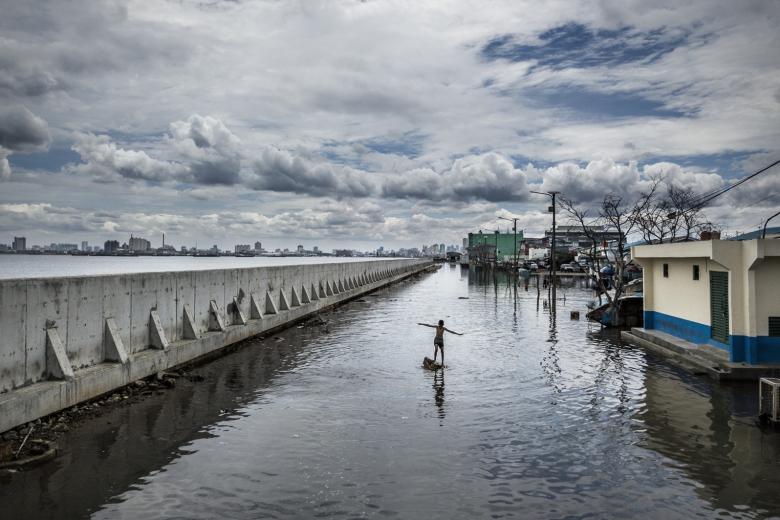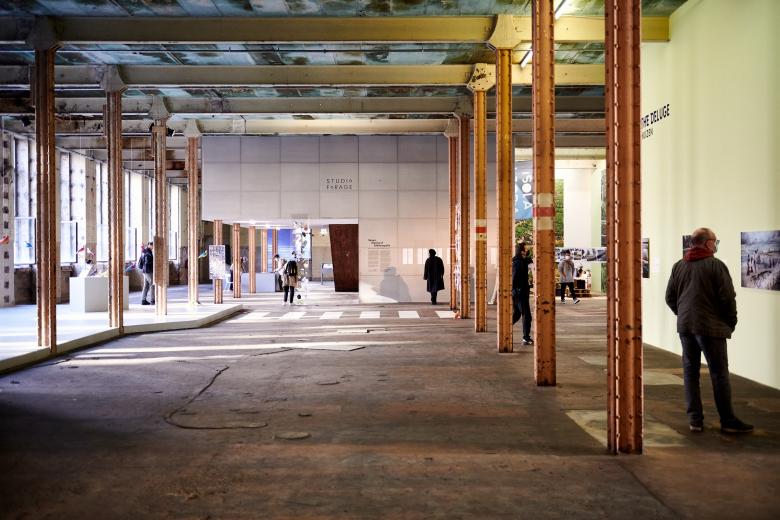The City of the Future Has Been Built!
Katinka Corts
9. February 2022
The newly built retaining wall cannot protect Jakarta from flooding. December 2018 (Photo: Kadir van Lohuizen)
"City of the future" is what we often read. Technologies are conjured up that will fundamentally change our lives in the future and reshape cities. This was cleverly put into perspective at the symposium The Future of Cities: Not for Granted, which took place in Leipzig at the end of January. If we want to influence the intensity of climate change through construction, we should not wait for the city of the future. Rather, it is a matter of adapting the existing buildings and at the same time putting people, who have to deal with technology, in the foreground instead of technology. What needs to be discussed, therefore, is the future of the existing city.
"The beginning of any development work must be an honest appraisal of our heritage," says Arnold Bartetzky. This honest stocktaking and look at failed utopias led to the realization, the Leipzig art historian and architecture critic continued, that the city of the future has already been built and that the current building stock is sufficient. This must be dealt with, he said, if cities are to be adapted to the challenges of climate change. Bartetzky was one of many participants in the two-day symposium at HALLE 14 in the former Leipzig-Lindenau cotton mill. Organized by the HALLE 14 Association, the art gallery in the west of the city was an analog and digital meeting place for numerous players from urban planning and research, university lecturers, architects, architecture enthusiasts, and many more. Due to the pandemic, the meeting was split, but it was organized very commendably. At the beginning of the event on Friday, live audience and digital attendees were guided through the closing exhibition The Future of Cities: Not for Granted. Since September 2021, eleven artistic and architectural examples of how people are responding to the challenges posed by climate change, digitalization, and migration have been on display.
The subsequent introductory lecture to the symposium was given by architectural theorist Ines Weizman, who teaches at the Royal College of Art in London and studied at the Bauhaus-Universität Weimar, among other places. Her topic was the layers of time in cities and how to (better) deal with them. For example, in the years after the political turnaround, numerous publications juxtaposed images of architecturally neglected East German cities with images showing the same places and buildings after redevelopment. Even though such redevelopments largely yielded a profit for the city — if one disregards fraudulent real estate entrepreneurs like Jürgen Schneider — they simultaneously eliminated old layers of time. Such were, for example, large housing estates like Grünau in the western part of the city of half a million inhabitants. As the buildings in Leipzig's city center became increasingly inhospitable during the GDR era, new housing estates on the outskirts of the city lured residents with central heating, a private bathroom in the apartment (and not halfway up the stairs, as was customary in buildings from the Wilhelminian period), appropriate apartment sizes, a green environment, and stores selling everyday commodities in the immediate vicinity. The neighborhoods had schools, there were recreational facilities and sports clubs; people liked to live in the new housing estates on the outskirts of the city. When new buildings, e.g. shopping centers, were added to the estates after the fall of the Wall, this urban fabric lost its cohesion and also its previous reputation; the large estates became a kind of ghetto for those who could not afford to move into the redeveloped city center. According to Weizmann, a rethink is required here, because repeating old mistakes, i.e. tearing down shopping centers that are no longer needed, is simply a waste of resources. Instead, she said, clever reuse strategies must be applied to find a way of converting structures that have once been built for a new function. Running from one utopia to the next should no longer be the solution.
View of the exhibition (Photo: Walther Le Kon, 2021 © HALLE 14)
Quality of life comes before technology in the smart cityAgain, it is the honest consideration of heritage that Bartetzky and many others urged. And again and again the call came up for acting with more moderation instead of developing large-scale projects that merely satisfy short-sighted interests. At the same time, Stephan Sigrist, who founded the think tank W.I.R.E. (Web for Interdisciplinary Research & Expertise) in Zurich, warned that smart cities must not only be efficiency-driven, but must above all focus on society. In the minds of many people, the future of cities would already be quite concrete: the abandonment of combustion engines, the use of autonomous vehicles, green buildings for greater sustainability, and digital networking as the basis for efficiency and safety. However, he said, it was also important to redefine the quality of life in urban areas and one's own degrees of freedom. Many digital applications still fail because social factors are not taken into account. He also agreed: The city of the future has been built! What we need now is cross-cutting cooperation as the basis for a truly smart city.
However, in a city that is oriented toward society and social issues, the public must also assume more responsibility for housing and the common good, claimed Andrej Holm. In his lecture, the social scientist from Berlin emphasized that public welfare and private profit maximization cannot be reconciled. Legal foundations will only be helpful until private individuals complained about them or find loopholes in the legislation. Subsidy programs are no solution for secure social housing either, because they are limited in time. If a program is not attractive enough, people will not invest in it — which ultimately leads to adjustments to the programs.
Since aesthetics and beauty have a hard time in urban planning discussions, the panelists suggested to pay more attention to quality of stay and the things in a city that make the space pleasant — that will then also be sustainable. The post-Covid city will be a different one anyways, as numerous existing issues have been given more room in discussions during the pandemic. How will we deal with office space in the future? How and where do we meet in everyday life? How important is retail in the city and (how) can it continue to function in the future? Even if it currently hurts to encounter vacancies on the ground floors of cities, perhaps they also present an opportunity. In the past, as was pointed out in the discussion, countless department stores smothered the city centers; today they are becoming fewer and fewer. People are now shedding tears over the department stores and fail to understand that this also opens up opportunities for something new. "We plead not to lapse into lamentation, but also to see the opportunities," they said, "and to look at the world with a desire for difference and discourse and to joyfully disagree, because new things emerge from this."
View of the exhibition (Photo: Walther Le Kon, 2021 © HALLE 14)
Giving shape to the commonAt the beginning of the symposium, it was timidly suggested that the outcome of the two days could possibly supplement the Leipzig Charter. The first version of this charter, signed in Leipzig in 2007 by all 27 ministers responsible for urban development in the European Union, included elements for a resilient city. In the more recent 2020 version, the charter no longer merely identifies the tasks but also the principles according to which European urban planning must function in order to enable equitable, green, and productive cities. Looking at existing and failed models in particular helps to make observations and learn from them. On the podium it was stated that architects have the claim to leave behind beauty, but at the same time planners should move away from the idea of building for eternity. The city in transition needs more temporary structures, because the future is not about designing spaces but rather about giving shape to what is common. Viewing urban space as a space for experimentation, allowing bottom-up and self-build projects wherever possible, are important factors here. One possible way could be to not only develop the process design together with all stakeholders but also to keep them involved in the projects in the long run. A kind of "common good quota," i.e., a fixed quota for the participation of nonprofit organizations in building projects, could make intensive participation the new standard and create beacons of the experiment.
The idea of summarizing the most important points of all the discussions in a thesis paper and disseminating it was still alive at the end of the symposium. However, there needs to be publicity for these topics and not just debates in small circles. As one of the participants said, the big developers and investors never take the front seat at such panels, and the goal would be to start tackling this issue here and achieve more understanding.
One of the most important issues will be to place a central value on public good-oriented land policy in the future. It is idle to discuss the abolition of property. But it could and should be linked to a concrete social duty. The current spiral system boosts money-making and screws up prices, while at the same time the state rewards real estate sales with tax exemption after ten years. This is a good starting point: Reducing taxes on rents after ten years, or even exempting them, would give landlords an incentive to keep properties and tenants and would create the possibility of establishing a new kind of tenant-landlord relationship. Since the post-unification sell-off of the real estate market, Leipzig, one of the most important and fastest-growing cities in eastern Germany, has painfully experienced how financial interests can destroy entire urban fabrics. Whether families, the elderly, students, creatives, or artists, those who once inhabited the districts of Lindenau and Plagwitz can hardly afford apartments or studios there anymore, since demolition, new construction, and luxury renovation prevail. But the circles of this price spiral and the accompanying neglect of the common good can no longer be afforded by any city that doesn't want to see itself plunged deeper and deeper into social and economic injustice — which is certainly not conducive to the city's climate policy future.
The former factory building was refurbished and expanded from 2008 to December 2012 in accordance with the existing utilization concept. The visitor center as well as the exhibition areas, workshops, and storage areas were completed successively. The aim of the refurbishment and expansion was to preserve the authenticity and spaciousness. The visitor center of HALLE 14, the exhibition space on the ground floor, the partner spaces on the second floor, and the studio of the art education program demonstrate the careful approach to this industrial monument from the Wilhelminian period.
Related articles
-
Vessel to Reopen with Safety Netting
1 week ago
-
DS+R Expands DS+R's Broad
4 weeks ago
-
The Vibes Co-Space
1 month ago


